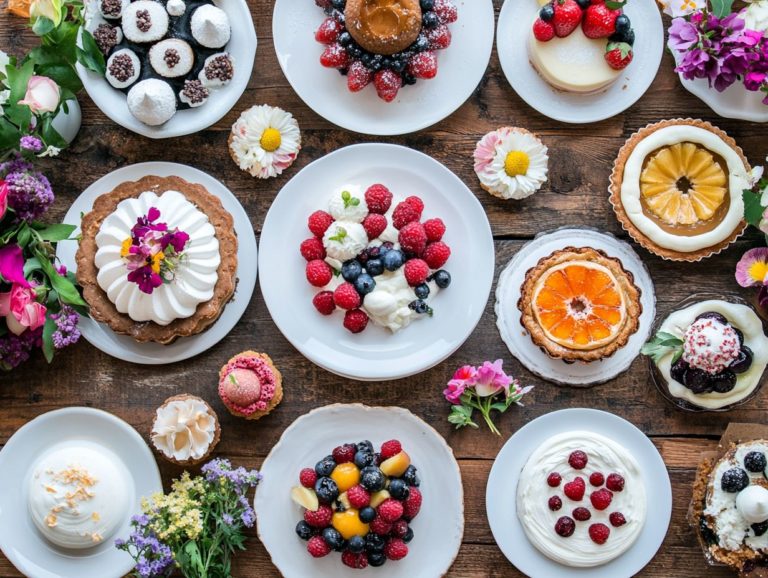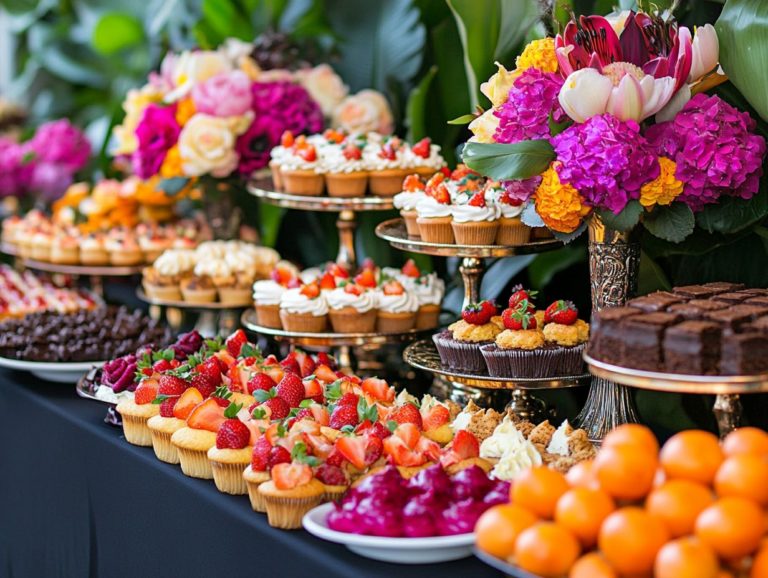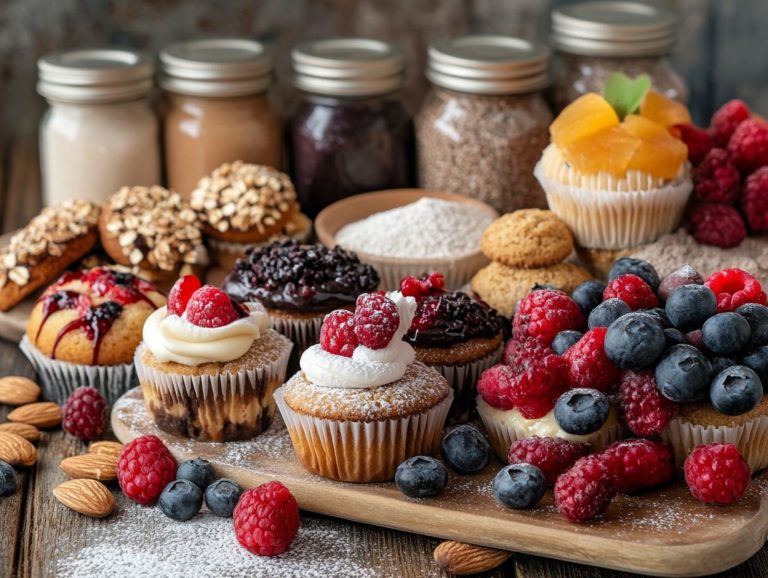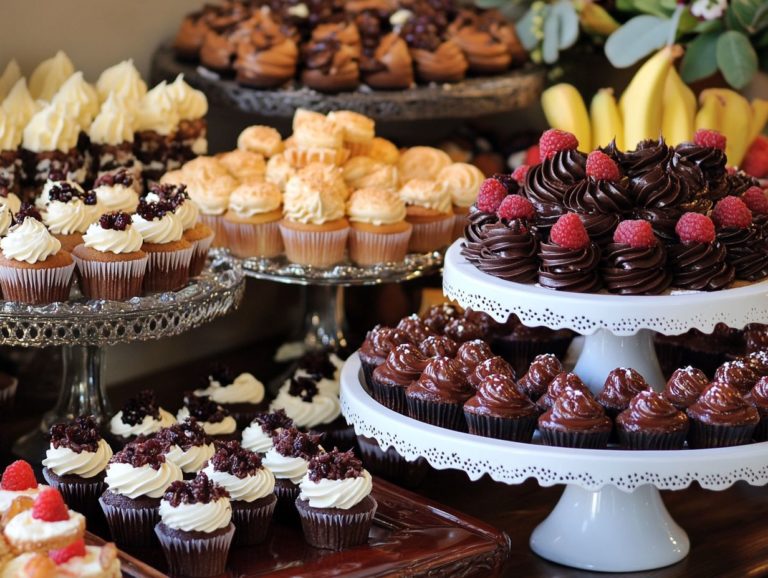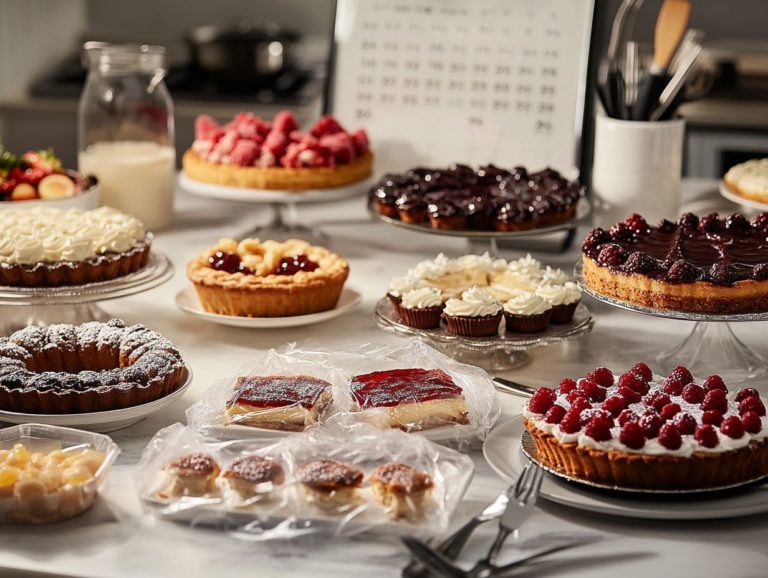What Is the History of Popular Desserts?
Contents
- The Fascinating History of Desserts
- Key Takeaways:
- The Origins of Desserts
- Early Desserts Around the World
- The Rise of Modern Desserts
- What Was the Impact of Industrialization on Desserts?
- How Did World Wars Shape Dessert Culture?
- The Influence of Technology on Desserts
- How Did Refrigeration Change Dessert Options?
- What Role Did Television Play in Dessert Popularity?
- How Has Social Media Impacted Dessert Trends?
- Famous Desserts and Their History
- What Is the History of Chocolate Chip Cookies?
- How Did Ice Cream Become a Popular Dessert?
- What Is the Story Behind Apple Pie?
- How Did Cheesecake Become a Favorite Dessert?
- Your Questions About Desserts Answered!
- What Is the History of Popular Desserts?
- When did desserts first become popular?
- What are some of the earliest and most popular desserts?
- How did desserts evolve over time?
- What role did colonization play in the history of popular desserts?
- Which cultures have had the biggest influence on popular desserts?
- How have modern advancements in technology and food production affected popular desserts?
The Fascinating History of Desserts
Desserts boast a rich and captivating history that spans cultures and centuries. They have evolved from simple confections into the intricate delights you savor today. From ancient civilizations to the bustling kitchens of modern restaurants, dessert recipes have continuously changed.
Join us on an exciting journey to discover the origins of desserts, tracing the path back to the very first sweet treats and their remarkable transformation over time. From traditional dishes to decadent creations, dessert culture tells a fascinating story.
You ll uncover early desserts that traveled from Europe to Asia and learn how pivotal events like industrialization and world wars have shaped dessert culture as we know it.
Delve into the impact of technology and social media on dessert trends. You’ll also discover the fascinating stories behind iconic treats such as chocolate chip cookies, ice cream, and cheesecake.
Embark on this delicious journey through the history of desserts and indulge in the flavors of the past!
Key Takeaways:
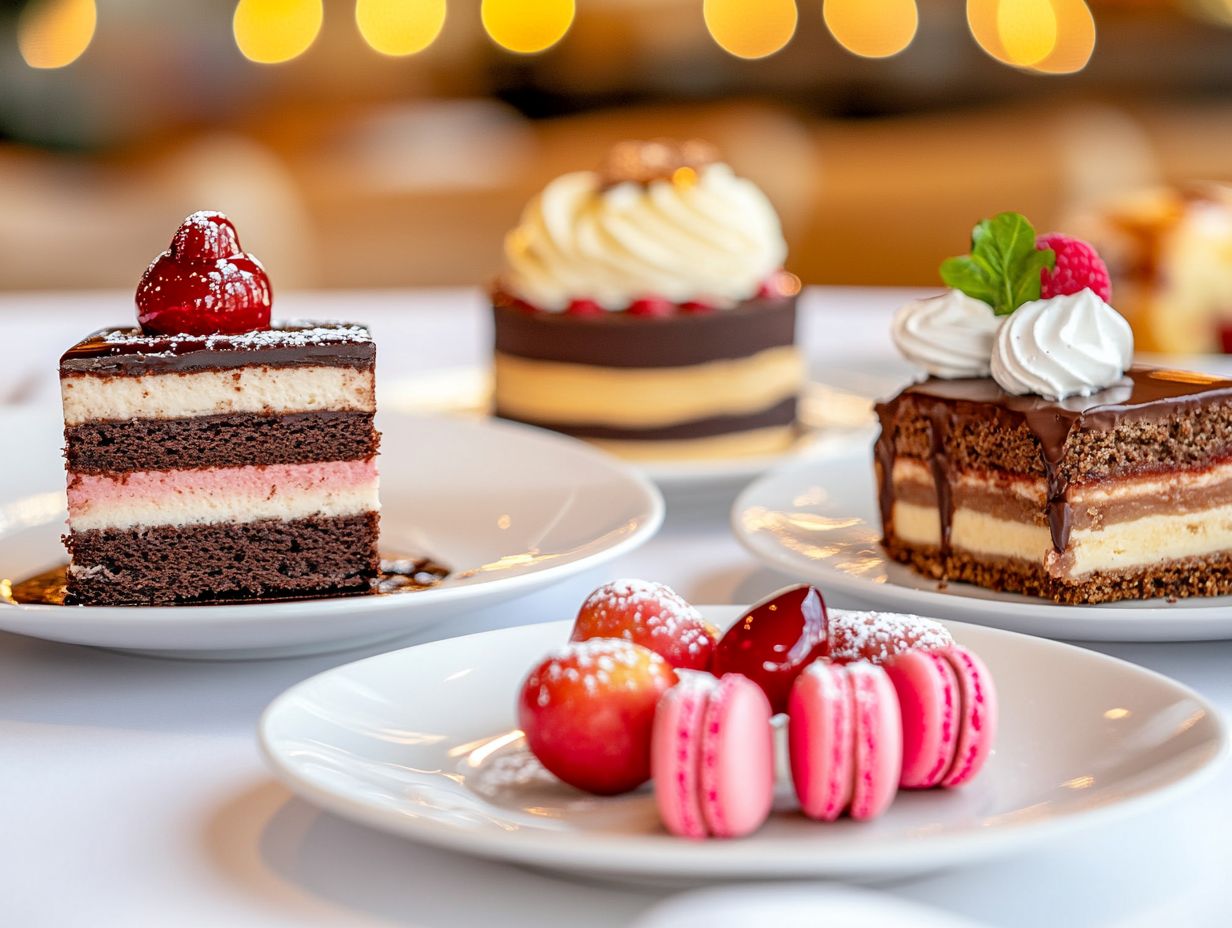
- The first desserts date back to ancient civilizations and evolved into the sweet treats we know today, such as apple pie and custard.
- These desserts drew influences from various cultures, showcasing unique flavors and ingredients across Europe, Asia, Africa, and the Americas.
- Modern desserts have been shaped by industrialization and global events, while technology has made them widely accessible.
The Origins of Desserts
The origins of desserts can be traced back to ancient civilizations, where sugar was first cultivated. It was incorporated into various forms, eventually evolving into the delightful sweet dishes you enjoy today.
Initially, these sugary creations were a luxury reserved for wealthy individuals, but as new ingredients and techniques emerged, they broadened the food scene, introducing a medley of flavors and textures across different cultures.
This evolution flourished during the Middle Ages when desserts began to gain significant prominence in Europe.
Today, desserts encompass a vast array of sweet dishes that reflect global cultures and culinary practices. They showcase the rich history and evolution of these cherished meal courses. From traditional pastries to innovative ice cream flavors, the dessert spectrum is ever-expanding.
What Was the First Dessert?
The first dessert is thought to have been a straightforward sweet dish crafted from honey and fruits, enjoyed by ancient civilizations like the Egyptians and Greeks.
These early sweet treats did more than conclude meals on a delightful note; they carried significant cultural and ceremonial weight. Often prepared for festivals or religious rituals, these confections highlighted the creativity of these societies in harnessing natural sweeteners like honey, paired with seasonal fruits.
Ingredients such as dates, nuts, and dried fruits found their way into these dishes, reflecting local agricultural practices and trade at the time. These early desserts often accompanied savory dishes, enriching the overall culinary experience.
The opulent presentation of these sweet creations signaled social status, hinting at the extravagant desserts that would develop in the centuries to come.
This rich history laid the groundwork for modern desserts, weaving together gastronomy with tradition and celebration in a way that continues to resonate today.
How Did Desserts Evolve Over Time?
Desserts have undergone a remarkable transformation over the years, shaped by diverse cultural practices, the availability of ingredients, and advancements in culinary techniques that have given rise to an enticing array of variations in global cuisines.
Throughout history, desserts have reflected the preferences of societies and the innovations of technology, including advancements in sugar production and ingredient accessibility.
In ancient times, you would find honey-sweetened delights like baklava, showcasing the agricultural bounty of the region. The Middle Ages brought marzipan and sugar-based confections, made possible by the flourishing spice trade. During the Renaissance, elaborate cakes emerged, heavily influenced by Italian and French recipes, with designs that mirrored the artistic spirit of the era.
As sugar became more accessible in the 18th century, delightful pastries and custards began to flourish across Europe, paving the way for iconic treats like cr me br l e and napoleon. In today s world, globalization continues to diversify the dessert landscape, melding traditional elements with innovative techniques.
This has led to unique creations such as matcha tiramisu and churro ice cream sandwiches, showcasing how the world enthusiastically celebrates the joy of sweets.
Early Desserts Around the World
Early desserts from around the globe reveal the distinctive culinary practices and ingredients unique to each region, showcasing an array of traditional dishes that have endured through time and still delight your palate today. This includes everything from Mochi and Wagashi in Japan to brownies and cupcakes in the United States.
In Europe, you ll find sweet treats like pastries and custards taking center stage, while Asia introduces you to delightful confections such as Mochi and Wagashi. The United States, known for its diverse culinary influences, offers popular items like donuts and milkshakes.
Africa shines with its honey-based desserts, and the Americas contribute rich chocolate and fruit-infused delights to the dessert landscape.
These early indulgences were not merely treats; they also played a vital role in cultural celebrations and social gatherings, highlighting how sweet foods are woven into the very fabric of culinary heritage worldwide.
What Were Some Early Desserts in Europe?
Some of the earliest desserts in Europe included an array of pastries, honey cakes, and fruit tarts, all of which were favored by the aristocracy during lavish banquets and feasts.
These exquisite confections were meticulously crafted with sumptuous ingredients like rich butter, eggs, and finely milled flour, illustrating the remarkable culinary innovation of the era. Take the honey cake, for instance; its natural sweetness was enhanced with spices such as cinnamon and nutmeg, showcasing the influence of trade routes that brought exotic flavors to the continent.
Similarly, fruit tarts brimming with seasonal fruits not only tantalized the taste buds but also symbolized the abundant harvests cherished in local cultures. As these early desserts evolved, they paved the way for the sophisticated pastry creations and cake traditions that now epitomize modern European cuisine.
What Were Some Early Desserts in Asia?
In Asia, you ll find that early desserts like Mochi and Wagashi beautifully showcase the use of rice and sweetened bean pastes, reflecting the region s rich agricultural practices and cultural heritage.
These delightful confections are not just indulgent treats; they hold significant meaning in various traditions and festivities. Take the Japanese New Year, for instance, where Mochi graces celebratory dishes, symbolizing prosperity and vitality. The artful creation of Wagashi aligns seamlessly with the Japanese tea ceremony, where the aesthetics of the dessert elevate the entire experience into one of mindfulness and a deep appreciation for nature.
In many Asian cultures, these desserts are crafted using time-honored techniques passed down through generations. This practice reinforces community ties as families come together to prepare these delicacies for special occasions, ensuring that cherished recipes and the stories behind them are lovingly preserved.
What Were Some Early Desserts in Africa?
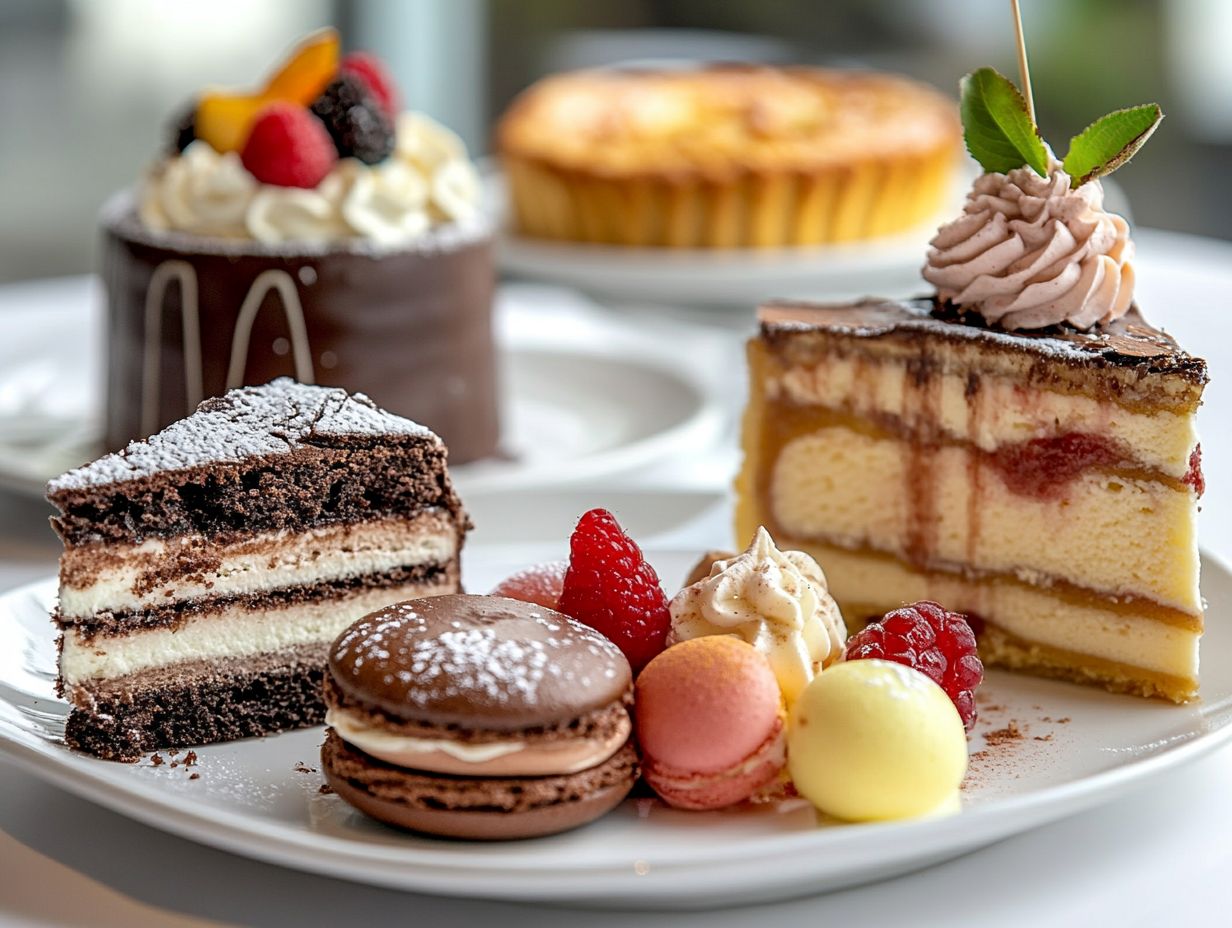
Early desserts in Africa often showcased the natural sweetness of ingredients like honey and fresh fruits. Traditional confections were crafted especially for festivals and significant events.
These delightful treats, often made from locally sourced ingredients, represented more than just culinary indulgence; they embodied community spirit and togetherness. For example, dishes such as biltong (a type of dried cured meat) and maize pudding became central to family gatherings during harvest time. Meanwhile, honey-soaked pastries were cherished at weddings and religious celebrations.
The inclusion of aromatic spices like cardamom and cinnamon in many of these sweets accentuated the rich flavors of the region. Desserts transcended mere sustenance, occupying a treasured space within the cultural fabric of African societies, symbolizing unity and joy.
What Were Some Early Desserts in the Americas?
Early desserts in the Americas prominently featured chocolate and various fruit-based sweets, highlighting the region’s rich agricultural diversity and cultural influences. Delicacies such as fudge and mousse eventually emerged, enriching the dessert repertoire.
These delectable treats arose from a blend of indigenous ingredients like cacao, alongside fruits such as berries and plantains. The introduction of European flair during colonization further enhanced their appeal.
Indigenous peoples skillfully utilized natural sweeteners and native crops. In contrast, colonial influences brought in sugar and new baking techniques that transformed the culinary landscape. This fusion led to the creation of beloved dessert recipes that continue to be enjoyed today.
For example, the Aztecs cherished chocolate as a revered drink, often infused with spices, paving the way for future dessert innovations. This culinary crossroads symbolizes the fusion of diverse traditions and reveals how societies adapted their palates to embrace new ingredients and shared culinary practices.
Today, this legacy is celebrated in iconic desserts like tiramisu and macarons.
The Rise of Modern Desserts
The emergence of modern desserts is primarily linked to the groundbreaking innovations of the industrialization era. This pivotal period enhanced access to key ingredients such as sugar and chocolate, transforming dessert production techniques and sparking a remarkable wave of creativity in dessert recipes.
Interestingly, the Middle Ages also set important precedents in dessert evolution, with early forms of chocolate being consumed in Italy and France.
This era represented a significant shift in dessert culture. Mass production enabled a plethora of new sweet dishes to grace both restaurants and homes. It refined the palates of the burgeoning middle class, who eagerly embraced these decadent indulgences.
What Was the Impact of Industrialization on Desserts?
Industrialization significantly transformed the world of desserts by making ingredients like sugar more accessible and affordable. This shift sparked an exhilarating era of dessert creativity and variety in desserts.
With the democratization of ingredients, both bakers and home cooks had the opportunity to experiment with a plethora of flavors and textures. This experimentation led to the creation of iconic treats that were once considered luxuries. The newfound access to a variety of refined flours, chocolates, and alternative sweeteners sparked creativity in recipe development, giving rise to delightful styles like layer cakes, cream-filled pastries, and cookies boasting an array of textures.
Advancements in mass production techniques allowed desserts to be made and sold on a larger scale. This era also saw the introduction of delightful treats like donuts, fudge, and cupcakes, which became popular in the United States. This resulted in the emergence of bakery chains and packaged confections, quickly becoming household staples. Renowned establishments like Laduree in France and Whisked in the United States began to flourish during this time. This remarkable transformation not only expanded the range of dessert options available but also fundamentally reshaped societal eating habits, intertwining sweets into the fabric of daily life. Concurrently, unique desserts like tiramisu from Italy and mochi from Japan started gaining international appreciation.
How Did World Wars Shape Dessert Culture?
The World Wars profoundly influenced dessert culture, as rationing compelled both home cooks and chefs to think outside the box. With limited ingredients at their disposal, they had to innovate and craft alternative sweet dishes that still delighted the palate.
During these trying times, traditional recipes underwent significant transformations. Bakers replaced essential staples like sugar and butter with substitutes such as honey, oil, and even applesauce. This not only enabled families to create desserts despite scarce resources but also opened the door to a delightful array of flavors and textures they may not have otherwise ventured into.
As a result, innovative creations emerged, such as sponge cakes crafted with less flour and puddings thickened with cornstarch. This period also gave rise to brownies and mousse, both of which became household favorites. In the post-war era, the echoes of these experiences continued to resonate through dessert trends, fostering a newfound appreciation for resourcefulness in the kitchen. This paved the way for a culinary movement that celebrated comfort and nostalgia, forever shaping the landscape of sweet treats. Innovations by culinary figures such as Alfred Bird and the rise of wagashi in Japan are notable contributions from this era.
The Influence of Technology on Desserts
Technology has been instrumental in transforming the world of desserts, especially with the introduction of refrigeration. This innovation revolutionized how ingredients are stored and prepared, significantly broadening the array of desserts available for both enthusiasts and home bakers.
With refrigeration, you can create luscious ice creams and delicate pastries that were once challenging to master, such as macarons and milkshakes. This technological leap has paved the way for dessert trends to thrive in the social media era, where your visually stunning sweet creations can captivate food lovers around the globe. This influence is evident in the global popularity of desserts like mochi and whipped coffee.
How Did Refrigeration Change Dessert Options?
Refrigeration has fundamentally transformed your dessert options by enabling the preservation of perishable ingredients. This advancement allows you to indulge in a delightful array of chilled treats like ice creams, mousses, and custards.
This groundbreaking advancement not only extends the shelf life of dairy products, fruits, and other essential ingredients but also paves the way for innovative techniques in dessert preparation. With improved storage capabilities at your disposal, you can boldly experiment with diverse flavor combinations and textures, unleashing a wave of creativity in your culinary endeavors.
Desserts such as panna cotta and cheesecakes have truly thrived in the age of refrigeration. They benefit from the ability to set and stabilize at cooler temperatures. The harmonious balance of flavors and the allure of visually stunning presentations in these chilled masterpieces render them timeless favorites. They are enjoyed across cultures and occasions, exemplifying the big influence refrigeration has had on modern dessert artistry.
What Role Did Television Play in Dessert Popularity?
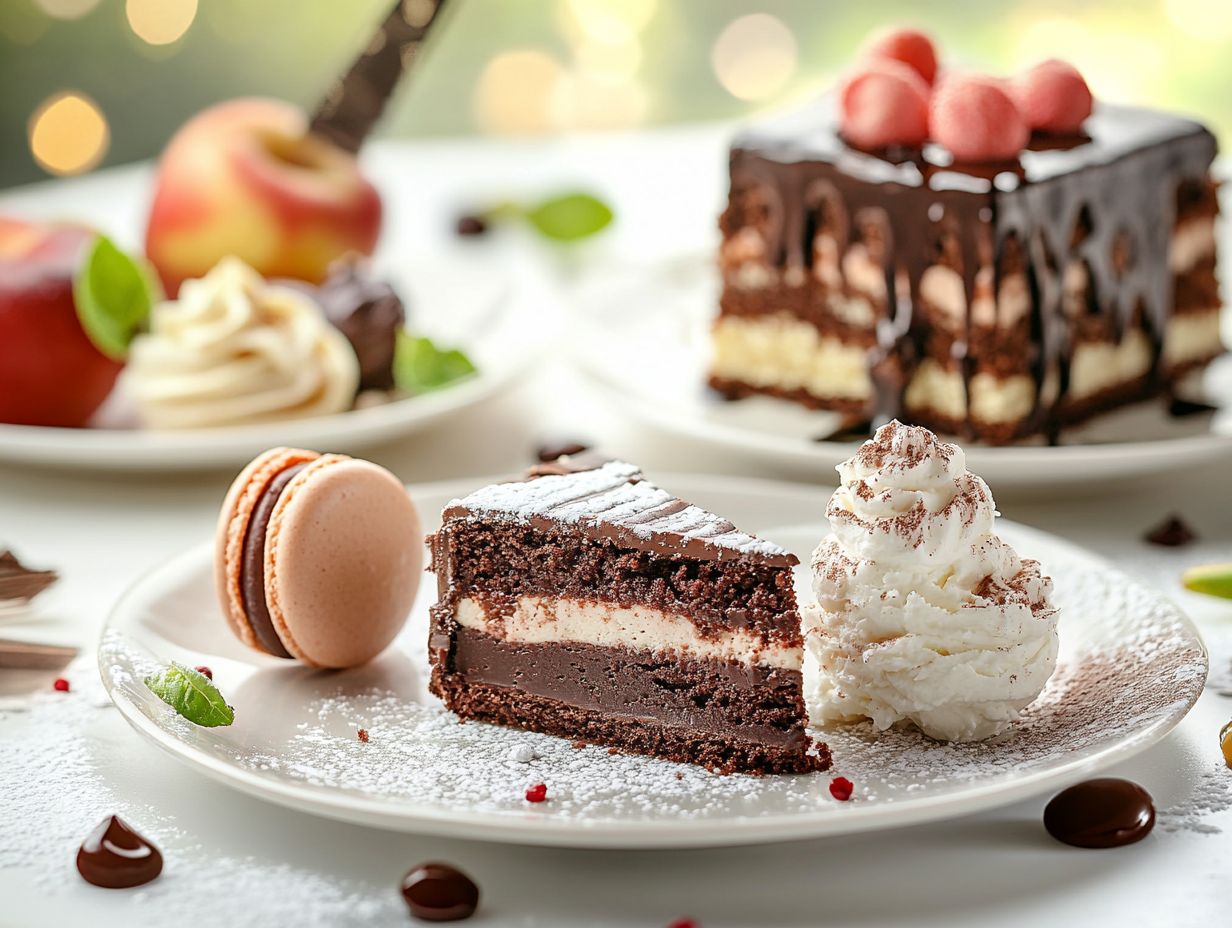
Television has significantly elevated the popularity of desserts, thanks to captivating cooking shows and competitions that highlight the skills of talented chefs. These shows showcase the allure of innovative dessert recipes, daring you to dive into the exciting world of sweet culinary creations.
Programs like ‘The Great British Bake Off’ and ‘Nailed It!’ have enchanted viewers, generating a delightful buzz around desserts and inspiring you to try your hand at baking. Shows hosted by culinary experts like RudiGourmand have also played a significant role in popularizing unique dessert styles. Chefs and personalities such as Claire Saffitz and pastry virtuoso Dominique Ansel have made a name for themselves by popularizing unique dishes, from gourmet doughnuts to intricate layer cakes, sparking viral trends across social media platforms.
This surge in visibility ignites a newfound passion for baking within your household. It fosters a community where home bakers enthusiastically share their creations, perpetuating the joy and artistry of dessert-making for all to enjoy.
How Has Social Media Impacted Dessert Trends?
Social media has revolutionized dessert trends, offering a vibrant platform where visually stunning treats can achieve viral fame. This shift allows home bakers and professional chefs to showcase their culinary masterpieces to an expansive global audience.
Platforms like Instagram and TikTok have been instrumental in this transformation. Their focus on captivating visuals and succinct, creative content captures attention effortlessly. Desserts such as whipped coffee and innovative layered cakes have not only grabbed the spotlight but have also encouraged countless individuals to explore their own kitchens with newfound enthusiasm.
The emergence of eye-catching trends think galaxy-themed sweets and intricately designed macarons illustrates how social media ignites creativity. With a kaleidoscope of colors and artistic flair, these trends inspire your followers to engage with delectable visuals. They motivate them to recreate, adapt, and share their own versions.
This interaction cultivates a vibrant community of desser aficionados who continuously innovate and inspire one another.
Famous Desserts and Their History
Famous desserts such as chocolate chip cookies, ice cream, apple pie, and cheesecake each boast rich histories that illuminate their cultural significance and the evolution of dessert recipes over time.
You ll find that chocolate chip cookies rose to prominence in the United States during the 1930s, capturing the hearts and taste buds of many. Ice cream, on the other hand, has a long-standing legacy linked to royalty and indulgence in various cultures, making it a timeless treat. Interestingly, flavors like matcha from Japan and gelato from Italy have added to its global appeal.
Apple pie, often esteemed as a quintessential symbol of Americana, and cheesecake, which traces its origins back to ancient Greece, collectively demonstrate how desserts have become cherished staples in culinary traditions around the world.
What Is the History of Chocolate Chip Cookies?
The history of chocolate chip cookies takes you back to the 1930s when Ruth Wakefield crafted her now-famous recipe at her Toll House Inn. What began as a simple variation on traditional butter cookies quickly transformed into a beloved treat that captured the hearts of people across the United States.
Using straightforward ingredients like butter, sugar, flour, eggs, and those iconic semisweet chocolate morsels, these cookies were destined for greatness. As home bakers embraced the delightful recipe, they not only indulged in their creations but also eagerly shared them, fueling the rapid ascent of chocolate chip cookies into the realm of culinary stardom.
Over the years, variations have flourished, incorporating nuts, oats, and even indulgent flavors like peanut butter or caramel. This evolving classic has solidified itself as a quintessential American dessert, cherished by generations.
From bake sales to holiday gatherings, chocolate chip cookies remain a steadfast staple in households across the nation, bringing joy one bite at a time.
How Did Ice Cream Become a Popular Dessert?
Ice cream has transformed from a luxury savored by aristocrats into a beloved dessert cherished by everyone, especially as its popularity surged in the 20th century due to improved production methods and an explosion of flavors.
This delightful treat has a rich history that spans thousands of years, with early versions crafted from snow and ice mixed with honey and fruit, enjoyed by ancient civilizations. As trade routes expanded, the knowledge of frozen desserts spread across continents, sparking innovations that made ice cream more accessible to all. The industrial revolution ushered in significant advancements in refrigeration and production techniques, paving the way for mass production.
In the 19th century, Americans wholeheartedly embraced this cool confection, leading to a wave of flavor innovations, including beloved staples like chocolate, vanilla, and strawberry, as well as newer additions like milkshakes and fudge. Today, ice cream occupies a treasured spot in various cultures, representing celebration and comfort, and solidifying its status as a universally adored indulgence. Countries like Japan have even incorporated their own unique flavors into this classic treat.
What Is the Story Behind Apple Pie?
Apple pie, a quintessential symbol of American culture, boasts a rich history that can be traced back to medieval Europe, ultimately evolving into the beloved dessert you enjoy today in the United States.
The earliest recipes for apple pie emerged in England and the Netherlands, where bakers combined various fruits with spices, encasing them in a crust that reflected the agricultural practices of the era. Baked goods like cupcakes and donuts have since become popular in similar ways. As European settlers made their way to America, they adapted these recipes, infusing them with native ingredients and local preferences.
Over the centuries, this humble dish transformed into an iconic representation of Americana, often gracing tables during holidays and celebrations.
With countless variations available from the classic double-crust to delightful crumb-topped creations each version offers a unique flavor experience. Today, apple pie stands as a testament to the nation s diverse heritage, frequently enjoyed at family gatherings, picnics, and Thanksgiving dinners, solidifying its status as a cherished staple in the American diet. Other desserts like mochi and wagashi also hold cultural significance in their respective countries.
How Did Cheesecake Become a Favorite Dessert?
Cheesecake is now a beloved dessert in countries like France, Italy, and the United States.
Cheesecake boasts a captivating history, tracing its origins back to ancient Greece and evolving over the centuries into various regional interpretations that have made it a cherished dessert across the globe.
This delectable treat finds its roots on the island of Samos, where the earliest recorded instances of cheesecake were served to athletes during the inaugural Olympic Games. As time marched on, this creamy delight journeyed through the Roman Empire, adapting to local flavors and ingredients, including honey and eggs.
Today, you can encounter cheesecake in countless forms ranging from the classic New York style, celebrated for its rich, dense texture, to the light and airy Italian ricotta versions. These variations highlight the versatility of its core components. Depending on where you are, you might discover unique toppings, crusts, and infusions that beautifully reflect the cultural influences on this cherished dessert. In Japan, for example, you’ll find variations influenced by wagashi.
Watch this video by RudiGourmand on the history of apple pie.
Your Questions About Desserts Answered!
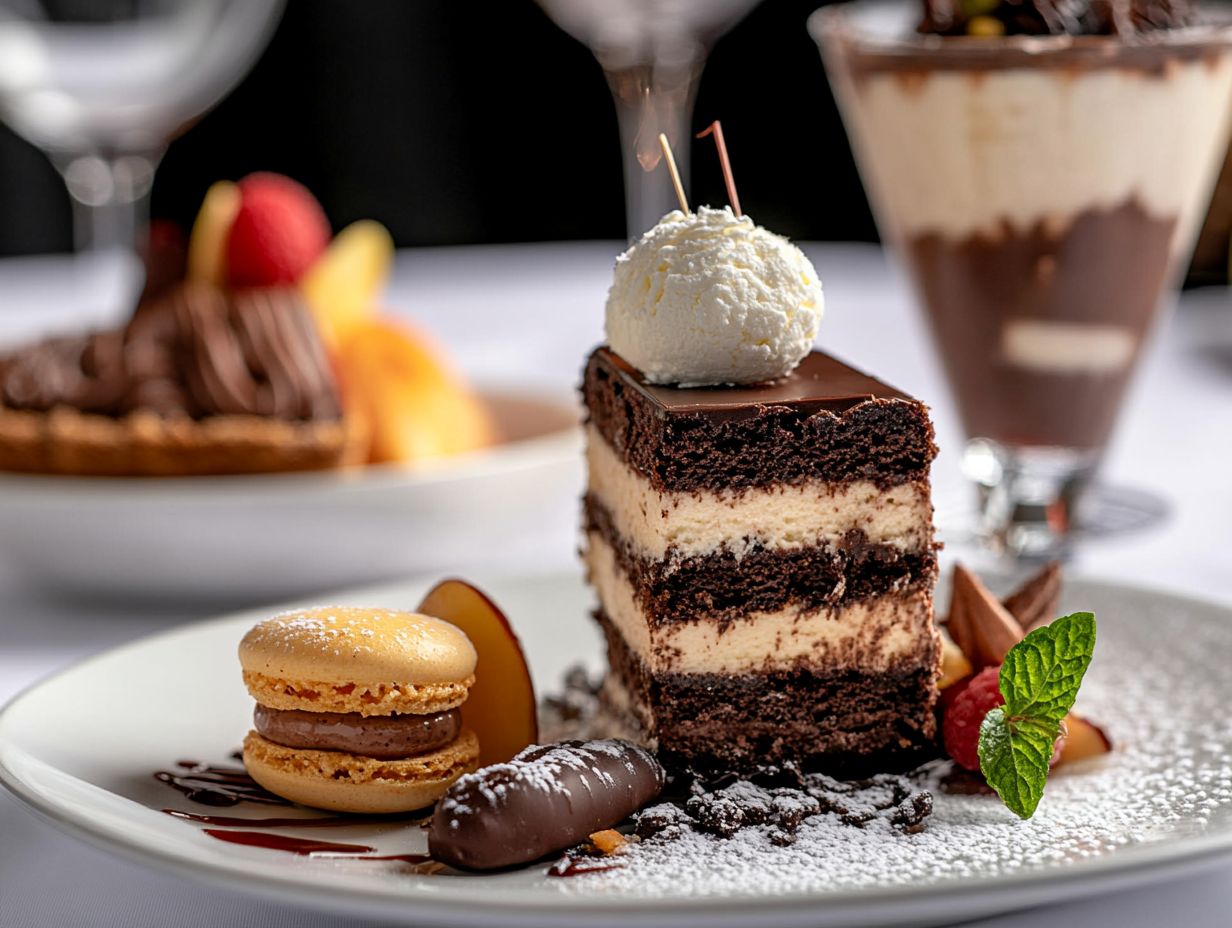
What Is the History of Popular Desserts?
Desserts have been enjoyed by people all around the world for centuries. They have evolved over time and have become a staple in many cultures. Here is a brief history of popular desserts.
When did desserts first become popular?
The concept of desserts can be traced back to ancient civilizations such as the Egyptians and Romans. However, desserts became more widely popularized in Europe during the Renaissance period in the 16th century.
What are some of the earliest and most popular desserts?
Fruit-based desserts, such as pies and tarts, were among the earliest recorded desserts. Other popular options included custards, puddings, and pastries, typically served in royal courts and wealthy households. Desserts like mousse and brownies have since gained popularity worldwide.
How did desserts evolve over time?
New ingredients and techniques changed desserts over the centuries. For example, the use of sugar became more widespread in the 18th century, leading to the creation of more complex and sweeter desserts.
What role did colonization play in the history of popular desserts?
Colonization led to the mixing of ingredients and recipes between different cultures, bringing new flavors and techniques into desserts. For instance, Alfred Bird invented custard powder during the Victorian era. The introduction of chocolate from the Americas also had a major impact on European desserts.
Which cultures have had the biggest influence on popular desserts?
Many cultures have significantly contributed to the world of desserts. However, French and Italian desserts have had a major influence, with classics such as cr me br l e, tiramisu, and macarons being enjoyed globally today. Famous patisseries like Laduree and Whisked showcase these delicacies.
How have modern advancements in technology and food production affected popular desserts?
The development of new technologies and mass production methods has made desserts more accessible and affordable. This democratization allowed the middle class to enjoy treats that were previously exclusive. It has also led to the creation of innovative desserts, such as ice cream, which have become widely popular worldwide.

